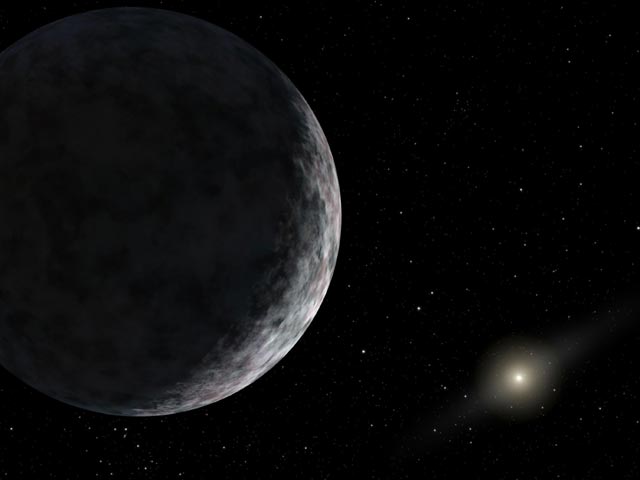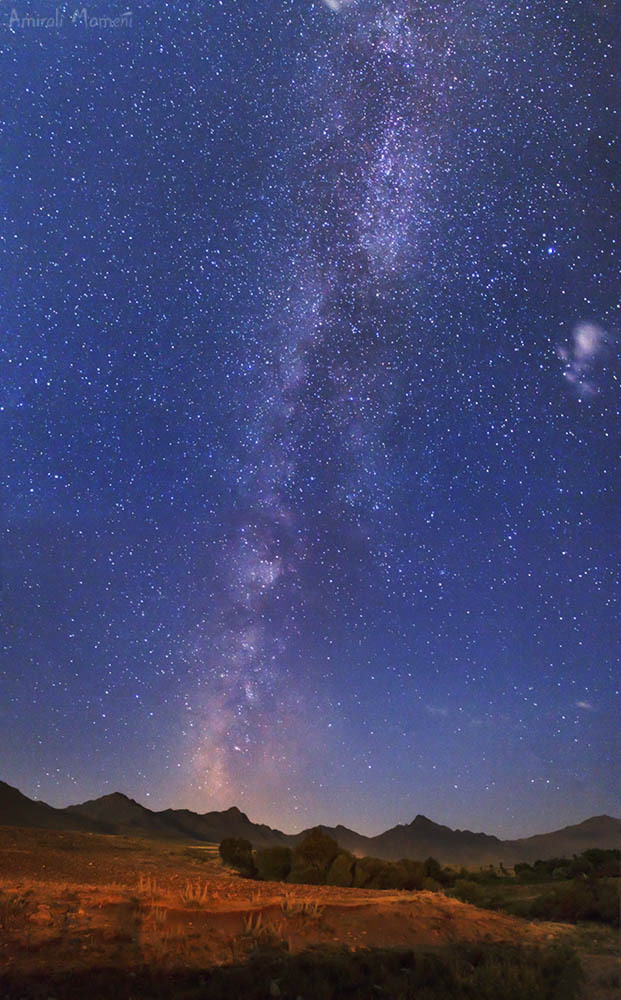Sky & Telescope Editor Honored
Sky & Telescope executive editor and Night Sky editor J. Kelly Beatty (right) receives the Harold Masursky Award from outgoing DPS chairman William B. McKinnon.Courtesy AAS / DPS. This week the American Astronomical Society's Division for Planetary Sciences (DPS) presented the 2005 Harold Masursky Award for outstanding service to planetary…

Why doesn't S&T produce a star atlas with mirror-image charts?
Why don’t you produce a star atlas with mirror-image charts? It would be of immense value to the many observers who use a star diagonal on their telescopes. It’s a great idea in theory, but not in practice. Here’s why: · economics. Printing two versions of an atlas would double…

Why are Kuiper Belt discoveries made at aphelion?
Why is it that so many of the recent Kuiper Belt discoveries — including the “10th planet,” 2003 UB313 — have been made while the objects are at aphelion? Timing and luck. Objects that orbit the Sun spend most of their time near the farthest point of their orbits, where…

How many stars are in the Milky Way?
What is the best educated guess for the number of stars in the Milky Way? I’ve seen figures ranging from “some 20 billion” to “just under 600 billion.” The first seems too low, whereas the latter too high. The short answer is, nobody knows. But your reasoning is sound: 20…

What is the faintest object imaged by ground-based telescopes?
I know that the Hubble Ultra Deep Field imaging campaign reached a limiting magnitude of 31, but what is the faintest object imaged by ground-based telescopes? Furthermore, how is it that an amateur astronomer was able to reach magnitude 24 with a 16-inch telescope, when even Hubble has gone no…

Why do you need a hydrogen-alpha filter to see solar prominences?
If I can see solar prominences with the naked eye during a total eclipse, why do I need a hydrogen-alpha filter to see them at other times? During a total eclipse the Moon completely blocks the Sun’s photosphere, or visible “surface,” allowing prominences (and the corona) to shine in all…
If asteroid 99942 Apophis ever strikes Earth, how big would the crater be?
If the near-Earth asteroid 99942 Apophis ever strikes Earth, how big would the crater be? Apophis (formerly 2004 MN4) ranks at the top of the worrisome-asteroid list. On April 13, 2029 (yes, that will be a Friday the 13th), it will pass only 30,000 kilometers (18,600 miles) from Earth’s surface…

Will we ever see a mirror image of the conjunction of Venus and crescent Moon, as depicted on the Turkish flag?
On the evening of April 19th 2007, I witnessed a spectacular conjunction of Venus and the screscent Moon with earthshine. The cusps of the crescent pointed left (south) as the Moon set in the west. Will we ever see a mirror image of this event as depicted on the Turkish…

What percentage of our galaxy’s stars move in retrograde orbits?
Do astronomers have any idea what percentage of our galaxy’s stars move in retrograde orbits? The short answer is yes, a very small percentage. But the long answer is more interesting. First, let’s agree what we mean by “retrograde.” If you were to look down on the solar system from…

Why are the Large and Small Magellanic Clouds not listed among the Caldwell objects?
Why are the Large and Small Magellanic Clouds not listed among the Caldwell objects? They are also not given in Stephen James O’Meara’s book The Messier Objects in the list of 20 spectacular non-Messier objects nor among O’Meara’s 20 spectacular non-Caldwell objects in The Caldwell Objects. Are they too bright?…
How can binary stars orbit each other so fast?
In a News Note (S&T: November 2004, page 16) you described WR 20a, a binary star in Carina with components of 83 and 82 solar masses and an orbital period of 3.686 days. How can two huge balls of gas move so fast? Grab any introductory astronomy textbook and turn…

BASIC Programs from Sky & Telescope
Examples of celestial computation from the dawn of the home-computer age.

Why doesn't a GPS receiver read longitude 0° 00' 00" while standing on the prime meridian at the Greenwich Observatory?
Why didn’t my GPS receiver read longitude 0° 00' 00" when I visited Greenwich Observatory and stood on the prime meridian? The NAVSTAR satellites of the Global Positioning System can provide your location to an accuracy of 3 meters (10 feet) or better. The coordinates you get are based on…

Did that earthquake off the coast of Sumatra alter Earth's rotation and tilt?
Did the earthquake off the coast of Sumatra that triggered the horrific tsunami on December 26, 2004, alter Earth’s rotation and tilt, as some news stories suggest? The Sumatra earthquake released as much energy as 475 megatons of TNT. That’s some 23,000 times the energy released by the atomic bomb…

When we say a galaxy is 300 million light-years away is that its distance now or 300 million years ago?
When we say a galaxy is 300 million light-years away, is that its distance now or 300 million years ago? Oftentimes, neither! In most cases astronomers try to get a handle on a galaxy’s distance by measuring its redshift: the degree to which the universe’s expansion has stretched its light…

Are machine-made telescope mirrors better than those made my hand?
Are machine-made telescope mirrors better than those made my hand? In general, no. Making a telescope mirror is a two-step procedure. First you generate and refine the curve in the glass, and then you carefully modify that curve, in the process known as figuring, to give the mirror’s polished surface…
How is the date of Easter determined?
How is the date of Easter determined? The rule most people remember is that Easter falls on the first Sunday after the first full Moon following the March equinox. In practice, Roman Catholic and Protestant churches follow a method of calculation adopted with the Gregorian calendar reform of 1582. The…

How will you know when you telescope mirrors need re-aluminizing?
I have read that telescope mirrors require periodic re-aluminizing. How will I know when mine needs this? While it’s true that the aluminized surface of a telescope mirror will deteriorate over time, there is no hard and fast rule about how long this will take. Some coatings last only a…

What should I do if my telescope mirror is dusty?
I took my new scope out last night and pointed a flashlight down the tube. My mirror looks really dusty. What should I do? The answer is simple: Don’t shine a light down the tube at night! Seriously, it only makes the dust look a lot worse than it is.…
Press Center
Sky & Telescope is known worldwide as "The Essential Magazine of Astronomy." For more than 60 years we've helped people of all ages and interest levels to appreciate the night sky by providing accurate, timely skywatching information. Our editors collectively have more than 160 years of experience at the magazine…
